

At 6:45 AM, Chris pulled up to Pittsburgh's Union Station in a Chevy HHR and we loaded my bags then made our escape. We were delayed because there was a no left turn sign at the station exit, which prevented us from easily getting to the freeway, so we had to find another longer way out of town. The good news was that we saw a lot of Pittsburgh on the way to US 22 and we took the Pennsylvanian Turnpike for $5.50 to Bedford.

We drove the road east before stopping at a Sheetz petrol station for some snacks. Once off the turnpike, we turned south on US 220 to Cumberland and easily found the station, thanks to the excellent directions on their website, for our first new train trip of this journey, the Western Maryland Scenic Railroad.
Western Maryland Railroad HistoryThe oldest portion was the Baltimore, Carroll and Frederick Railroad which was chartered in 1852 and began building west from Baltimore. The railroad was completed to Hagerstown, Maryland in 1872. Within a year, its name was changed to Western Maryland Rail Road Company and eventually, it became Western Maryland Railway Company. The Connellsville Extension was built west from Cumberland, Maryland, to Connellsville, Pennsylvania, beginning around 1906 and was completed in 1912.
In 1931, the Western Maryland became part of the Alphabet Route, a competitor to more major railroads, including the Pennsylvania Railroad. Thus, although never a giant, the Connellsville subdivision of WM handled through midwest fast freight traffic and coal from company-owned mines near Fairmont, West Virginia and Somerset, Pennsylvania. In 1930, the Pittsburgh and West Virginia Railroad Company reached Connellsville to hook up with the WM. That line operates today as the Wheeling and Lake Erie Railway. In 1964, the Chesapeake and Ohio Railway (C&O) and the Baltimore and Ohio Railroad (B&O) jointly filed for permission to acquire control of the Western Maryland Railway with the Interstate Commerce Commission.
In 1973, as part of the Chessie System, the Western Maryland ownership went to C&O and it was operated by the B&O. In 1987, it was merged into the C&O, which itself became part of CSX Transportation. Much of the original Western Maryland line has been abandoned including the crossing of the Allegheny Mountains and the Eastern Continental Divide near Deal, Pennsylvania after going through Savage Mountain in a 3,000 foot tunnel.
The Western Maryland Scenic Railroad HistoryThe Western Maryland Scenic Railroad is a heritage railroad based in Cumberland, operating over former Western Maryland Railway trackage to Frostburg and back using both steam and diesel locomotives and operates passenger excursion trains and occasional freights when needed out of the former Western Maryland station in Cumberland, which also houses one of the six visitor centers of the Chesapeake and Ohio Canal National Historical Park, as well as other attractions and offices. This station was built in 1913. The railroad offers coach and first class service, as well as reserved caboose rides and runs murder mystery excursions and special seasonal trips.
The track, which for the most part follows a former Western Maryland Railway line, proceeds northwest from Cumberland through "the Narrows", a deep water gap formed by the passage of Wills Creek between Haystack Mountain and Wills Mountain, parts of the Wills Mountain Anticline geological structure. The train then proceeds up the Allegheny Front through a water gap formed by Jennings Run, passes Mt. Savage and terminates at the former Cumberland and Pennsylvania Railroad depot in Frostburg. The train lays over there for about ninety minutes to allow passengers to visit the town, and the locomotive is turned back there on a turntable that originally served the Western Maryland in Elkins, West Virginia. The train then returns to Cumberland by the same route.
Intermediate sights on the line include Helmstetter's Curve in Cash Valley, Brush Tunnel and Woodcock Hollow, site of a hairpin curve. The Allegheny Highlands Trail of Maryland, part of the Great Allegheny Passage bicycle trail from Cumberland to Pittsburgh, Pennsylvania, runs along the route of the Western Maryland Scenic Railroad. Cyclists can make reservations with the railroad to put their bikes on board for the climb up the mountain to Frostburg, then cycle back down to Cumberland.
Regular power on the railroad is 734. Normal power for the train is former Lake Superior and Ishpeming Railroad 34, now known as Western Maryland 734, a 1916 Baldwin-built 2-8-0 steam locomotive painted in WM "fireball" livery with a different tender from its original. The locomotive came to the line from the Illinois Railway Museum in 1991. After an extensive rebuild, it entered service in 1992; it has received several modifications over the years to give it more of a WM appearance.
The WMSR operates out of the former WM's Ridgeley, West Virginia car shops located just across the Potomac River from Cumberland. The shops include offices, a Federal Railroad Administration building, and the former paint shop which is now used to house the steam engine and perform repairs on the railroad's equipment. The WMSR shops also serve as a business offering restoration services for locomotives and coaches from both commercial and private owners. South, past the Ridgely shops and yard, the WMSR also maintains a wye that is used to turn the railroad's locomotives and coaches.
Since its creation, the WMSR has gained an extensive collection of lightweight style passenger coaches, many of which it either has restored to service in its tuscan and gold livery, or has used for parts to restore other coaches. Many of the restored coaches are painted with the names of local area towns, as well as benefactors of the scenic railroad. The WMSR also has a collection of freight equipment it has collected from CSX and other sources that it uses for storage at the shops, rail line maintenance, and photo freight excursions. The WMSR currently also has three cabooses; two former Chesapeake and Ohio and one former Western Maryland. Other un-restored equipment includes an former Chessie System crane, a former Amtrak material handling car, heavyweight coaches and pieces for a turntable.

While Chris parked, I went inside the station to pick up our tickets then returned to the car for my camera.

The Western Maryland station. In the 19th century, Cumberland emerged as one of the East Coast's major transportation gateways. Three major transportation routes started in Cumberland -- the National Road (America's first highway), the B&O Railroad (one of America's most profitable railroads) and the C&O Canal (one of that era's most challenging engineering undertakings). Brought by road, rail, and water, Cumberland prospered by helping channel the raw materials, products and people flowing between the East Coast and the new states lying on the far side of the Appalachian Mountains.
Seeking to compete with the growing transportation monopoly of the B&O Railroad, the state of Maryland chartered the Western Maryland Railway in 1853. Hoping to claim a portion of the lucrative Cumberland to Baltimore route, the Western Maryland ran north and west from Baltimore along the Pennsylvania border. In 1913, the Western Maryland constructed the grand Cumberland station as a symbol of the railroad's power and importance. An imposing nine bays wide, the railroad station is surrounded by a heavy modillioned brick cornice located just under the roof line. Passengers of the Western Maryland Railway arrived in Cumberland overlooking a railroad station dramatically placed in a river valley where the Potomac River meets Wills Creek. The Station remained in use as a passenger terminal until 1958.

The former railroad's name is prominently displayed.

A trackside view.

The station with the Cumberland River in front.


The Chesapeake and Ohio Canal.

Clinchfield Railroad caboose 1072, later Seaboard 11072, built by the railroad in 1948.

This marker reads "The Western Maryland Railway Honor Roll World War 1 1917-1918. Out of the over 680 men on the list, only 20 "Paid the Supreme Sacrifice" being killed for their country."
At 10:40 AM, the Capitol Limited, which I rode to Pittsburgh, rolled east out of Cumberland. We waited at the east end of the platform for our train to arrive from its storage location.

First Western Maryland GP30 502 and Western Maryland 2-8-0 734 pulled the train across the bridge over the Canal.

Western Maryland 502 cut off on the fly then passed us.

Western Maryland 734 then came across the bridge but stopped.





Western Maryland 734 then started up and put on a great show approaching the station. It was built by Baldwin Locomotive Works in 1916 as Lake Superior & Ishpeming Railroad 18 and re-numbered 34 in 1923. After working out of Marquette, Wisconsin, it was retired in 1951 and stayed on the company's dead line at Marquette until the railroad sold three locomotives to the Marquette & Huron Mountain tourist railroad in 1963. 34 worked for four years hauling passengers from West Yard to Big Bay, Wisconsin and West Yard to Marquette, on old LS&I trackage. In November 1967, the locomotive was sold to the Illinois Railway Museum. Then, in 1991, it was bought by the WMSR and underwent a restoration and rebuild, including increasing boiler pressure to 200 psi, replacing the tender with New York Central Mohawk 2662's, as well as a number of other cosmetic changes to make it more resemble a WM H-7 class 2-8-0.

The rear of our train. A walk forward was now in order.
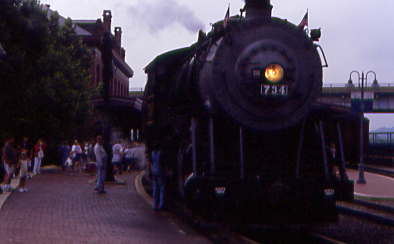
Our train at the station.

Across the tracks with both Western Maryland 734 and 502.

Western Maryland Scenic Railroad 2-8-0 734.

Taking on water. Our consist was Western Maryland Scenic Railroad 2-8-0 734, WMSR coach 876 "Cumberland", WMSR coach 726 "Man O' War", WMSR coach 880 "Frostburg", WMSR lounge 200 and WMSR 110. Chris and I then boarded, choosing a a vestibule for our first ride on this fantastic railroad.

We departed at 11:30 AM and soon passed Western Maryland GP30 502, ex. Conrail 2175, nee Reading Railroad 5507, built by Electro-Motive Division in 1962.

Crossing the Chesapeake and Ohio Canal.

Passing some of the freight cars used during steam photo freights.

Next, our train entered the Narrows and it was here I had my first cinder in my eyes. I had forgotten that this engine was a coal burner and left my eye goggles at home, so taking pictures meant I had to be careful.
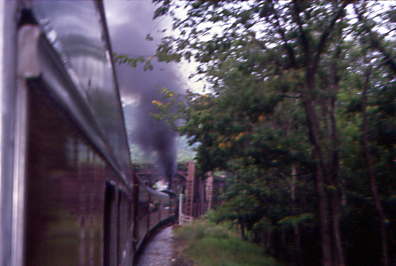
Our train approaching the Bridge in the Narrows, where Wills Creek cuts between the 1,000 foot Haystack and Wills Mountains. For years this was a natural access point west to the Ohio Valley. The old B&O (now CSX) line and the National Road (40A) run on the other side of Wills Creek.

Crossing the highway and Braddock Run on a 300 foot truss bridge built in 1910. It is about 60 feet above the water level of Braddock Run. A second track was once here and in the future, it will be a cycling and hiking trail that once finished, will follow the entire length of this railroad.

Our route took us through the forests as we ran along the slope of the hill. From Braddock Run, the line continues about two miles further near Wills Creek heading northeast before swinging back through almost 180 degrees into Cash Valley. Near this point is a rock cave often pointed out by WMSR crews and known as "Bone Cave". It was uncovered when a new cut was being excavated along Andy's Ridge for the railway in 1912. The cave was found to contain fossilised bones of forty-one different species, a number of which were from the Pleistocene Age, including a sabre tooth tiger. Today, little is left of the original contents.

The view looking out between the trees.



Next our train rounded the famous Helmstetter's Curve with the barn below.

On the approach to Brush Tunnel.




Passing through Brush Tunnel, constructed in 1911 by the Western Maryland Railway as part of its expansion from Cumberland to Connellsville. The walls of the double-track tunnel are constructed of cement and at either end is a rectangular cement portal with an arched opening and a corbeled edge. It is 914' long and 26' high from the rail head and was originally built with two tracks but, as one track has been abandoned, this allows the Allegheny Highlands Trail, part of the Great Allegheny Passage Trail, to pass through the tunnel for both hikers and cyclists.
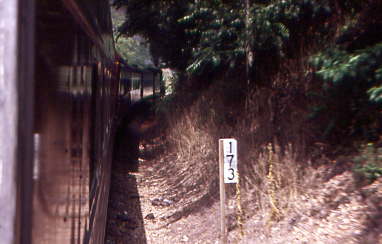
Our train passing MP 173. The track rounds the north face of Piney Mountain and continues high above Jennings Run for about two miles.


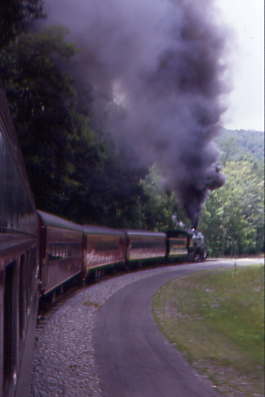

Contining the climb towards Frostburg.

We ran near the Woodcock Hollow and another horseshoe curve.

After our train passed beneath a former Western Maryland Railroad signal bridge, we arrived at Frostburg, where the two of us detrained.


The train in front of the station. Frostburg depot was built for the Cumberland & Pennsylvania in 1891 and now has a seating area where passengers can eat lunch. The township of Frostburg is on the east side of Big Savage Mountain, about 2,000 feet above sea level and 1,500 feet above Cumberland. It had its beginnings in 1811, when work started on the National Pike, a road built to transport crops and raw materials over the Alleghenies to East Coast markets. It was called Mount Pleasant until 1820, when the postal service arrived and it was renamed Frostburg. It now has a population of about 8,000 and is home to the Frostburg State University.
We then climbed the stairs that overlook the turntable.
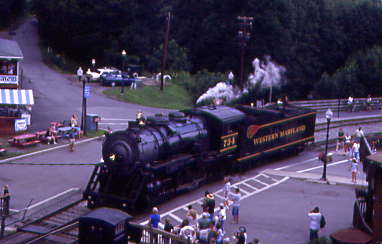

Western Maryland 734 had cut off the train and approached the turntable.




Turning on the turntable.


Pulling off the turntable with Chris Parker in these views.


The train after Western Maryland 734 had been turned.


The steam engine in Frostburg. I then went to get an ice cream on this hot and humid afternoon and stopped at a bathroom to wash the cinders off myself before sitting on a bench in the shade to wait for our return trip. I reboarded and chose a seat in the "Man O' War".


The train drifted downgrade on the return.

After rounding Helmstetter's Curve, Chris and I moved into the much cooler "Cumberland" coach for the remainder of the trip. It had been a fantastic ride aboard the Western Maryland Scenic Railroad and it is one I think everyone should take! Back at Cumberland, we detrained for a few more pictures.

Back in front of the Cumberland Station.
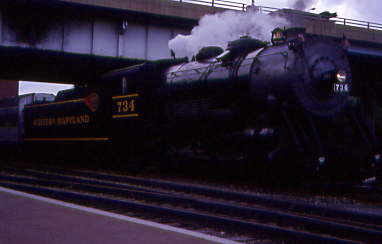
Western Maryland 734, a new steam engine for both Chris and I.

Our engineer was now getting ready to take it back across the river to the shop.

The impressive Western Maryland fireball emblem, introduced in 1940 and lasted and until 1952. The railroad was known as "The Fast Freight Line" and it was much more than just a slogan.


Western Maryland 734 on its way back to its shop.

Next Western Maryland GP30 502 was getting ready push the passenger cars back to the shop.



Western Maryland 502 took the cars home across the Chesapeake and Ohio Canal.

A last look at the Cumberland Station. I went inside and bought a T-shirt and post cards before we said our goodbyes to the Western Maryland Scenic Railroad.
On To Sand PatchOur next location to visit would be CSX's Sand Patch Summit on the Keystone Subdivision. We left Cumberland but soon took a wrong turn that took us to Fairhope.

Here we caught an eastbound CSX helper set drifting down grade to Cumberland. We drove west towards the Sand Patch but made another wrong turn and missed another eastbound CSX freight. After a few miles of dirt roads, we found the main highway and a couple of left turns took us to the bridge at Sand Patch Summit.
Sand Patch was built by the Baltimore & Ohio and is located in the Allegheny Mountains of southwestern Pennsylvania. It is one of the most challenging railroad routes in the eastern United States, known for its steep grades, numerous curves, and heavy freight traffic. The double-tracked route is currently owned and operated by CSX Transportation as part of its Baltimore-Chicago mainl ine. The summit, Sand Patch, is the highest point on the CSX system and is a popular spot for railfans due to its scenic views and frequent train activity.
The grade comprises a track length of 100 miles and its ruling grade is 1.2 percent for eastbound trains and 1.8 percent for westbounds, making it one of the most technically demanding railroad routes in the United States. For more than a century, trains have fought the grade, where the B&O's main line to Pittsburgh crosses the summit of the Allegheny Mountain range at Sand Patch, Pennsylvania.
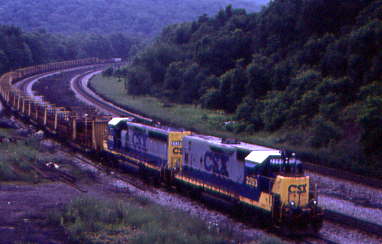
A CSX rail train, led by 2253, was sitting in the siding shut down for the late afternoon.

We heard a horn, signalling an eastbound train, which turned out to be a stack train led by BNSF and First Union Rail locomotives.

The train making its way toward the Sand Patch Tunnel.

The Summit of the Alleghenies sign. We decided to go west to explore, so drove to Meyersdale.

Here we found the Baltimore and Ohio station.

Western Maryland Meyersdale station built in 1912. Initially, the depot served two passenger trains in each direction daily, but regular passenger service ceased in 1931. The station continued to serve freight customers and as a maintenance base. After the Western Maryland Railway was abandoned in 1975, the building fell into disrepair.
It is home to the Meyersdale Area Historical Society which supports and promotes activities chronicling our area's story and participates in the development of interest, appreciation, preservation and research in the region's history. The station is leased from the County of Somerset which serves as a visitors' center, local history museum and trailhead on the Great Allegheny Passage hiking and biking trail. The station houses exhibits relating to the region's history, railroad-themed artifacts, operational model train displays featuring a children’s activity area, DVD programs highlighting trail and local attractions, in addition to oral histories and a gift shop. The station is typically open each April through October, offering hospitality and rest area facilities to trail users, tourists and local residents. Staff, volunteers, signage and printed materials at the visitors' center provide information about housing, food service, amenities and attractions not only for the Meyersdale area, but also throughout the county and along the trail.


Baltimore and Ohio caboose C3892 painted as Western Maryland 3235 built by International Car in 1969. We then drove to the former Western Maryland Salisbury Viaduct. The 1,908-foot viaduct soars 101 feet above the Casselman River just west of Meyersdale. The longest trestle on the Great Allegheny Passage, this steel structure was an engineering achievement for the Western Maryland Railway but it was not built without human cost. During construction in 1911, disaster struck when a travelling electric crane crashed to the ground while lifting a 14.5 ton girder. Six men were killed and one was seriously injured in the accident. A month later, another worker died when he fell off the deck of the viaduct. Like all the bridges on this part of the Western Maryland, it was built to accommodate a second track, which was never added. Hundreds of spectators cheered when the first train crossed in 1912. Abandoned as a through- route in 1975, it was decked for bicycle and pedestrian use in 1998.

The CSX mainline looking east.

We walked the full length of the bridge which is now a bicycle trail.

At the west end was this sign board.

The vista across with the valley, with Chris Parker in this view.

The Casselman River below. A CSX helper set dropped west under the Salisbury Viaduct and we returned back over it to the car.


Ground views of the Salisbury Viaduct.

CSX SD50-2 8505, nee Seaboard System SD50 8505, built by Electro-Motive Division in 1983.

CSX SD50 8601, nee Seaboard System 8601, built by Electro-Motive Division in 1983. We walked back to the car and returned to Cumberland through a driving rain storm in search of food, first trying TGI Fridays in Cumberland with no luck. Someone there needs to start a tri-tip sandwich stand and would be very successful.

We returned to the car, got our cameras and a photographed the westbound Capitol Limited running an hour late. On the way out of town, I stopped at KFC and Chris stopped at Wendy's then we drove West Virginia Highway 28 down to Romney after dark, passing our train for tomorrow. Once in town, we took US 50 east up the hill to the South Branch Inn where we spent the night.
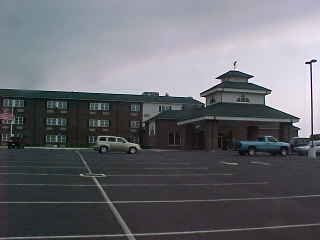
The South Branch Inn. Tomorrow we will ride the Potomac Eagle Scenic Railroad, but first a good night's rest.
| RETURN TO THE MAIN PAGE |